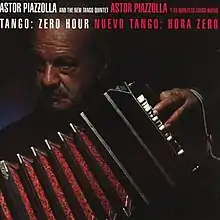Tango: Zero Hour
Tango: Zero Hour (Nuevo Tango: Hora Zero in Spanish) is an album by Ástor Piazzolla and his Quinteto Nuevo Tango (in English: New Tango Quintet, often loosely referred to as his second quintet). It was released in September 1986 on American Clavé, and re-released on Pangaea Records in 1988.[2]
| Tango: Zero Hour | |
|---|---|
 | |
| Studio album by | |
| Released | September 1986 |
| Recorded | May 1986 Sound Ideas Studio, New York City |
| Genre | Nuevo tango |
| Length | 46:07 |
| Label | American Clavé, Nonesuch |
| Producer | Kip Hanrahan |
| Review scores | |
|---|---|
| Source | Rating |
| Allmusic | |
| Robert Christgau | A–[1] |
Piazzolla considered this his greatest album.[3][4][5] Rolling Stone commented on the Pangaea reissue of the album, comparing Piazzolla's fusion of form, improvisation, and dynamics to contemporary classical music, jazz, and rock & roll, respectively.[6] Robert Christgau of The Village Voice also commented on Piazzolla's fusion of classical and jazz music.[5]
Track listing
All tracks written by Astor Piazzolla.
- "Tanguedia III" – 4:39
- "Milonga del ángel" – 6:31
- "Concierto para quinteto" – 9:06
- "Milonga loca" – 3:09
- "Michelangelo '70" – 2:52
- "Contrabajissimo" – 10:19
- "Mumuki" – 9:33
Musicians[7]
- Ástor Piazzolla – bandoneon, arranger
- Hector Console – bass
- Horacio Malvicino – guitar
- Fernando Suarez Paz – violin
- Pablo Ziegler – piano
Technical personnel
- Greg Calbi – Mastering
- Jon Fausty – Engineer, mixing
- Kip Hanrahan – Producer, engineer
- Nancy Hanrahan – Associate producer
- Scott Marcus – Executive producer
- Charles Reilly – Photography
- Shawna Stobie – Assistant engineer, mixing assistant
References
- Christgau, Robert (June 2, 1987). "Consumer Guide". The Village Voice. New York. Retrieved 2012-08-11.
- Azzi, María Susana; Collier, Simon (2000). Le Grand Tango: The Life and Music of Astor Piazzolla (illustrated ed.). Oxford University Press. p. 259. ISBN 978-0-19-512777-5. Retrieved 12 May 2009.
- Cook, Stephen. "Tango: Zero Hour". Allmusic. Macrovision. Retrieved 12 May 2009.
Considered by Piazzolla to be his best work, 1986's Tango Zero Hour was the culmination of a career that began in Argentina in the 1930s.
- "Tango: Zero Hour". Nonesuch Records. Retrieved 12 May 2009.
Astor Piazzolla called his recording Tango: Zero Hour 'absolutely the greatest record I've made in my entire life.'
- Christgau, Robert (2 June 1987). "Christgau's Consumer Guide: June 2, 1987". The Village Voice. ISSN 0042-6180. Retrieved 12 May 2009.
Piazzolla [...] claims this is the best of his 40 albums. [...] True semipop, dance music for the cerebellum, with the aesthetic tone of a jazz-classical fusion Gunther Schuller never dreamed.
- Rolling Stone. Wenner Media. ISSN 0035-791X.
Piazzolla's Argentine 'New Tango' fusion brazenly combines structural ploys from contemporary classical music and the improvisatory daring of jazz, heating the mix with swooping dynamics worthy of rock & roll
Missing or empty|title=(help) - "Tango: Zero Hour – Credits". Allmusic. Macrovision. Retrieved 12 May 2009.
This article is issued from Wikipedia. The text is licensed under Creative Commons - Attribution - Sharealike. Additional terms may apply for the media files.